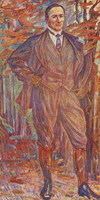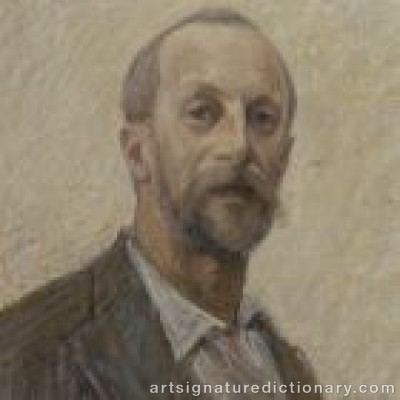Nationality Swedish Name J. G. Known for oil painting | Movement Onningeby colony Parents Nils Johan Andersson Spouse(s) Eva Topelius Children Fausto Acke | |
 | ||
Born April 7, 1859 ( 1859-04-07 ) Bergielund in Stockholm | ||
Johan Axel Gustaf Acke, usually called J.A.G. Acke, originally Andersson, (April 7, 1859 Bergielund in Stockholm - September 5, 1924 in Vaxholm), was a Swedish painter, illustrator and sculptor.
Contents
- Early life
- Education
- nningeby colony and marriage
- Career in Sweden and Finland
- Vaxholm
- Artworks and style
- References

Early life

Acke was the son of the botanist and professor Nils Johan Andersson and artist Anna Tigerhielm, and brother of the artist Elias Anckers. His sisters were also artistically active. He grew up in Bergielund, located between today's Vasa Park and Karlbergsvägen. His father, who was a curator at the National Museum had his official residence there. As a child he accompanied on his father's research trips to Lapland and Gotland and illustrated early father's work, with its floral notes.
Education
Acke was already like 14 -year-old student at the Art Academy's basically school, he continued his studies at the academy until 1882, and then he spent a period of Edvard Perseus free art school. He made study trips to the Netherlands and Belgium and to France where he studied etching FA Milus. Acke disliked academic studies and concluded the rebellious young artists at the Academy of Fine Arts, but completed his studies there, however .
Önningeby colony and marriage
Acke came to Åland 1886 and became a member of Önningeby colony, a Swedish-Finnish artist colony that appeared where roughly between 1886 and 1914. The founder was the Finnish painter Victor Westerholm. Acke painted much in Åland and got on with the other artists who saw him as a bit odd, energetic and humorous person. He spoke jokingly about Åland as "Maland." "Mower Man" is his most famous works from this period. Among the artists was a rebellious mood directed toward the academic painting and the Düsseldorf School. It was inspired by naturalism and later Impressionism. Acke differed from the other artists in that he also painted outdoor winter designs from Åland. Outdoor Painting outdoors in winter was unusual then for practical reasons. In 1887, Acke met his future wife Eva Maria Topelius in Önningeby, but the relationship was merely amicable. When emotions began to be torn between Acke and Anna Wengberg, a Swedish artist who also painted in Önningeby, it was Eva Topelius he married in 1891, daughter of the Finland-Swedish writer Zachris Topelius.
Career in Sweden and Finland

In the 1890s, Acke was with the restoration of the medieval wall paintings in Uppsala Cathedral . He worked for several years at a large painting, Snöljus, who represented winter fishing on ice in Åland and had high hopes of painting that was sent to the Salon in Paris, but was refused after which the couple Ackes visit to Åland thinned out somewhat. They lived at times in Finland and at times in Sweden during the early years of their marriage and participated in the Finnish art world. They spent much of his father in law, partly for economic reasons . After Zacharias Topeliusvägen death in 1898, they came to be increasingly directed towards Sweden and the Swedish art world .
Vaxholm
In 1901, the couple moved to Vaxholm, Acke and his home Villa Columbines . The marriage remained childless, but during a trip to Italy 1900-01, they met an Italian family, whose three-year-old son Fausto Alessio they adopted in 1903. In Sweden, the couple spent time with several of the passage of more famous artists Carl and Karin Larsson and Richard Lindstrom . Another acquaintance was Verner von Heidenstamsgatan, as Acke painted a portrait of . 1902-03 Illustrated Acke along with a couple of Finnish artists his father Zacharias Topeliusvägen Reading storybooks for children I and II. He took the name Acke in 1904 and was also working under the pseudonym I and I Acke
In 1912, Acke made an extended trip to Rio de Janeiro, which affected his paintings, especially his way of depicting light. The trip inroads However Ackes economy .
Ackes last major work was the frescoes of the Stockholm City Hall. While working on Sweden 's vision for the National Museum, he died suddenly .
Artworks and style
Meanwhile, in Önningeby Acke developed an impressionistic plein air style but later came his works have elements of expressionism, symbolism and art nouveau in works such as Night dew and sun rays in 1895, and the Forest Temple from 1901. After 1904 his work has often been linked in the hop with outdoor vitalism and its depictions of the naked human body, the sea and the sunlight, as in Morning Air 1911. After the trip to Brazil, his painting more impressionistic and sketchy in the handling of color and light in the Avenida Rio de Janeiro from 1912.
Acke painted portraits of the Bonnier family and also designed furniture in the Art Nouveau style at Bonnier family villa. Acke was in part also works as a sculptor. In their book Unlikely Stories (1919), he tells humorous about their whims and antics.
